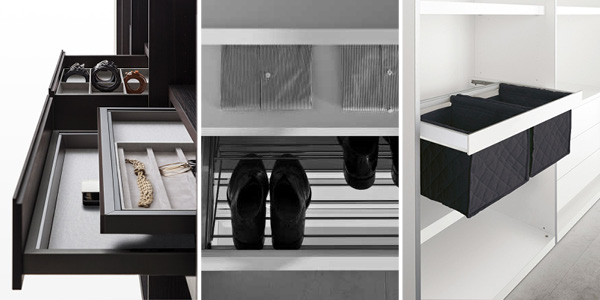Planning a custom closet is an exciting step toward transforming your space into an organized and functional haven. Whether your goal is to maximize storage or create a stylish, personalized wardrobe, understanding the essentials is key. In this article, we’ll share expert closet design tips that walk you through every stage of the process, from preparing for your project and planning a smart layout to organizing your walk-in closet and styling it into the dream space you’ve always wanted. By focusing on layout, materials, and storage solutions, you’ll be able to design a custom closet that enhances your home while fitting seamlessly into your lifestyle. Let’s explore the steps that will bring your vision to life.
Designing a Custom Closet: Focus on Functionality, Not Resale Value
When it comes to custom closets, a poorly designed closet costs the same to install as a well-designed closet. The difference is how you use the space. And while quality closets are seen as a plus in the real estate market, creating one isn’t about resale value, it’s about having a closet that perfectly meets your needs. When considering how to design a closet, it’s important to think about your specific needs and how you use the space.
Wall closets or reach-in closets are the most common type of bedroom closet. The minimum depth for a wall closet is 24 inches and the length of most closets is around 60 inches. Walk-in closets don’t necessarily take up more square footage than a large reach-in closet, but they do require a different shape space. Either way, whether you have a walk-in or reach-in closet, the space should be designed to your needs.
Here are a few important closet design tips to consider before you design, or redesign, your closet.
Prepare Your Perfect Closet
Designing a closet is about more than just hanging clothes, it’s about creating a space that reflects your lifestyle and makes daily routines easier. Before starting a custom closet remodel, take some time to think about your needs and habits. Begin with a complete inventory. Write down everything you plan to store, not just clothing but also items like handbags, luggage, jewelry, safes, or keepsakes. Many people keep parts of their wardrobe in guest rooms or basements, so be sure to include everything in one list.
Measure your belongings, plan and utilize your space
Note how much horizontal bar space your shirts, jackets, or dresses take up, and measure the longest items to ensure proper hanging height. Shoes, accessories, and folded items also need precise dimensions to design shelving and drawers that actually fit your lifestyle. If you’re sharing the space, consider each partner’s unique needs: one may need more hanging height, the other more drawers or shelves.
Think about how you want to use this closet. Do you picture a functional space where everything has its place, or do you want the boutique-like feel of Teatro walk-in closets, where design meets luxury? Ask yourself: how would you prefer your custom closets, strictly practical, or with space to linger, display, and enjoy? If shoes are your obsession, prioritize shelving. If clutter is your challenge, closed drawers may help keep the space calm.
Sketch, plan, and use every inch
When planning a custom closet, the first step is to sketch your space. Draw each wall to scale on graph paper and map out shelves, rods, and drawers. Pay special attention to corners since space there can only be used on one side. One of the most practical closet design tips is to think vertically: add high shelves 12–18 inches from the ceiling so no space goes to waste. For style, include a focal point such as a mirror, a built-in hutch, or a bank of drawers that breaks up the wall of clothing. Don’t forget to choose a front door style that complements the overall design, whether sleek sliding panels, mirrored doors for added light, or a classic hinged option, the door can define the closet’s look and functionality. As you explore custom walk-in closet designs, decide if an adjustable shelving system fits your needs, or if a carefully planned built-in structure is a better fit for your budget.
Prioritize storage and smart features
A successful design balances beauty and efficiency. Drawers are at the heart of any great system, they keep socks, T-shirts, jeans, sweaters, accessories, and even shoes neatly hidden while maximizing usability. Larger layouts can benefit from a packing island or storage bench, which add both drawers and seating. Another important part of how to plan a custom closet is to remember practical details: a hamper for laundry, shelves spaced for standard baskets, and corner solutions like angled shelving. Don’t forget electrical planning outlets for chargers or lamps, and integrated LED lighting to elevate the look. These details are what make Sipario walk-in closets stand out in both function and elegance.
Consider comfort, function, and style
The final layer of design is about lifestyle. A custom walk-in closet design should reflect how you live day-to-day. Add a full-length mirror for outfit checks, comfortable seating like an ottoman or bench, and if space allows a vanity or even a desk for a modern “cloffice.” Organize items into zones: workwear in one section, activewear in another, loungewear close at hand. Before finalizing, use painter’s tape on walls and floors to visualize shelving depth, rod placement, and flow. This extra step ensures your layout is functional before construction begins. With the right approach, planning a custom closet transforms your space into more than storage, it becomes a personalized, stylish haven built around your needs.
Give structure and keep things organized
The foundation of any custom walk-in closet design starts with organization. Before diving into layouts, take inventory of everything you own: clothing, accessories, and even items you may have tucked away in guest rooms or basements. Group similar pieces together and donate what you no longer wear. By knowing exactly what you have, you can determine the right balance of shelves, drawers, and hanging rods. For couples sharing a space, consider differences in wardrobes: longer men’s shirts versus shorter women’s blouses, or the need for handbags, ties, scarves, and jewelry. A closet doesn’t need to be split evenly; the layout should reflect what each partner actually owns. You can explore smart walk-in closet ideas to design a space that caters to both partners’ specific needs, ensuring everything fits perfectly.

These are just some of the storage possibilities available in a Pianca custom closet system.
Ergonomics also matter when planning a custom closet. Place open shelves at waist height so items are visible at a glance, keep drawers below for socks, underwear, and accessories, and reserve harder-to-reach areas for less frequently used pieces. While some drawers are essential, shelves often work better for items like sweaters or T-shirts, since they save space and keep your closet visually open. If you want a retail-like feel, this approach is a simple yet effective closet design tip.
To keep order, take advantage of unused areas. Hooks on blank walls are perfect for robes, belts, bags, or frequently worn jackets, while back-of-the-door organizers add instant storage. Acrylic shelf dividers prevent folded sweaters and pants from toppling into messy piles, and S-hooks on rods create neat displays for scarves, jeans, or tall boots. Vertical space matters, too: stacking bins, shoe boxes, or shelf risers ensure every inch is put to use. These small details are what make custom designed closets both functional and beautiful.
Stock up on smart features and finishing touches
Once the basics are in place, focus on the details that transform custom walk in closet designs into dream spaces. Drawer dividers and inserts keep small items like lingerie, jewelry, or sunglasses neatly separated, while file-folding methods make clothing easy to see and grab. Matching bins and cubes add a cohesive, high-end look, much more polished than a mix of mismatched baskets. Labels are equally important; clip-on or printed tags help you instantly identify the contents of high or opaque storage bins.
If you’re looking for inspiration on how to design a closet, products like Island Up walk-in closets and Anteprima walk-in closets show how thoughtful details elevate both form and function. From hidden hampers and smart electrical outlet placement to LED lighting and mirrored focal points, these design elements turn a practical storage space into a personalized retreat. By applying these closet design tips and thinking ahead about your lifestyle needs, you’ll create a closet that feels tailored just for you and one that will stay effortlessly organized for years to come.
Boutique style collection display, upgrades, lighting, rugs & more
A closet should be more than storage, it should be a personal sanctuary that feels both functional and inspiring. Once the layout is complete, it’s time to add the finishing touches that bring your space to life.
Our best closet design tips start with balance. While drawers are essential for small items, jewelry, or lingerie, we recommend limiting them for bulkier pieces like sweaters or T-shirts. Shelves make better use of space and offer a boutique-like display where you can instantly see what you own. The same applies to footwear: shoes should never live on the floor. Instead, we create mid-height shelving or pullout systems so every pair is visible and accessible.
To elevate your style, we often incorporate boutique-style displays: handbags on stands, hats neatly aligned, or statement shoes placed on risers. Matching hangers instantly add elegance, and valet rods let you prepare tomorrow’s outfit while doubling as a subtle design feature. For clients who want a personal touch, we introduce lamps, rugs, or wall art to create warmth, while wallpaper or painted ceilings bring unexpected character. Luxe lighting such as pendants or chandeliers is another simple way to add personality.
And for those seeking a higher level of luxury, the possibilities are endless. Beyond standard storage, how to design a custom closet today often includes integrated LED lighting, pullout accessories, or even boutique-inspired vanities. Some of our bespoke projects go further, adding espresso makers or dedicated coolers for cosmetics, proof that with the right design, your closet can become an everyday retreat.
Ultimately, the cost of a new closet design depends on the level of customization and the features you choose. Whether you’re envisioning a minimalist layout or a luxurious retreat, our role is to design a space that balances beauty, function, and your lifestyle.
Conclusion
A well-designed closet is more than just a place to store your clothing, it’s an extension of your personal style and a space that reflects how you live. By following our closet design tips and adding thoughtful, personalized touches, you can create a functional, organized, and stylish haven. Whether you’re looking for luxury elements, innovative storage solutions, or simply more space, we can help turn your vision into reality. Remember, every closet is unique, and the right design will always work around your needs and lifestyle.
FAQs
- How do I choose the best lighting for my closet?
Lighting plays a huge role in both functionality and ambiance. For optimal closet lighting, consider layering your light sources: overhead fixtures, task lighting for specific areas (like vanity lights or under-shelf LEDs), and accent lighting to highlight key pieces. LED lights are energy-efficient and can mimic natural daylight, making it easier to see clothing colors clearly. - Can I design a walk-in closet on a budget?
Yes, it’s possible to create a stylish walk-in closet without breaking the bank! Focus on essential elements first use open shelving for better visibility and maximize vertical space. For luxury touches, consider affordable alternatives like peel-and-stick wallpaper, budget-friendly lighting fixtures, or custom shelves made from cost-effective materials. - What’s the best way to store seasonal clothing in my closet?
To keep your closet organized year-round, store out-of-season clothing in bins or vacuum-sealed bags under the bed or in the top shelves of your closet. Rotate your wardrobe regularly to ensure easy access to current season clothes, and consider using a garment bag for delicate items to protect them from dust and damage. - How do I make a small closet feel bigger?
Maximize space by using mirrored or light-colored materials, which reflect light and create the illusion of a larger space. Slimmer storage solutions, such as slimline hangers and vertical storage, can also save space while making the closet feel open and airy. Keep the layout uncluttered by using baskets or bins to store smaller items out of sight.




